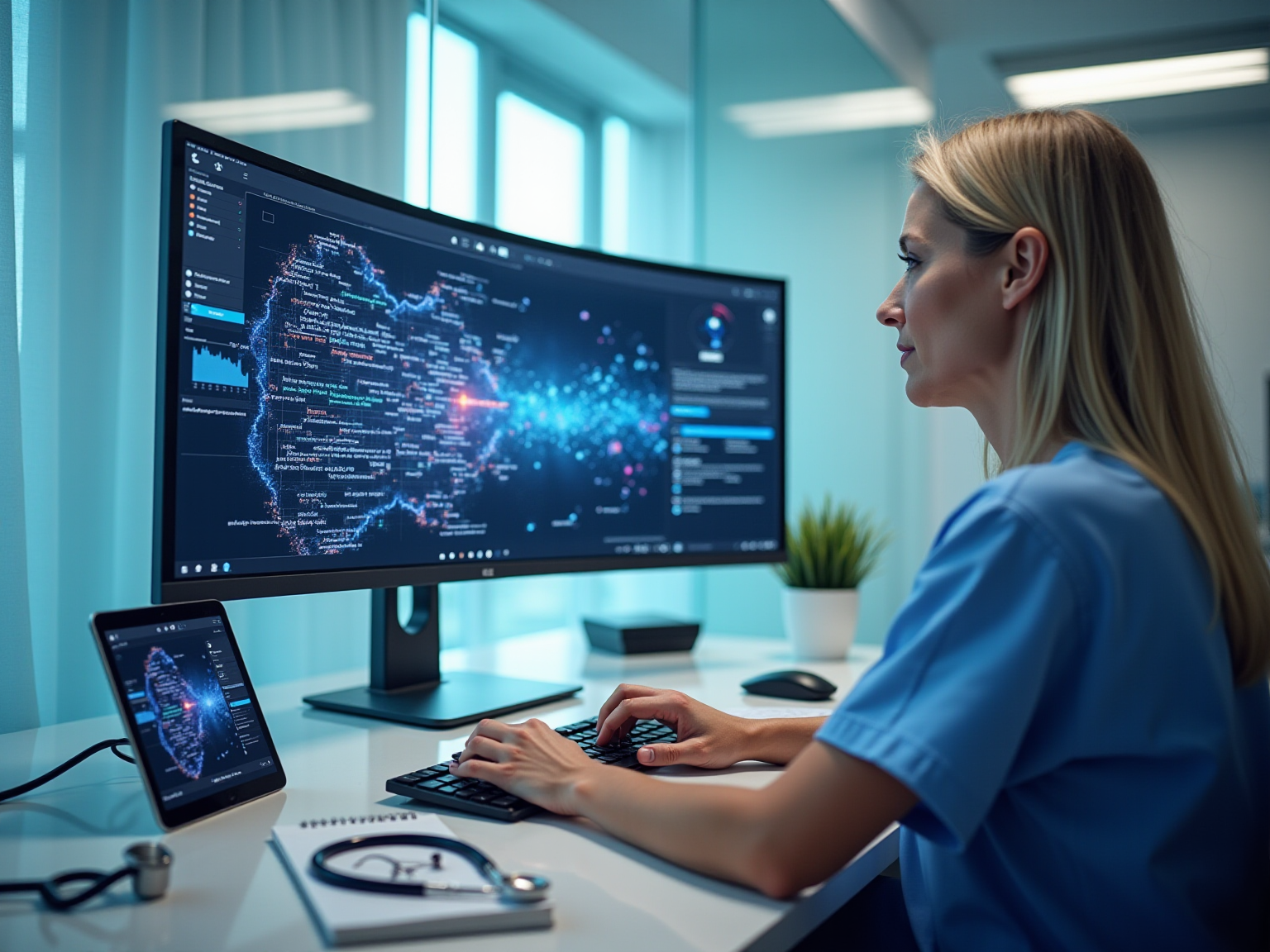Overview
We recognize the transformative potential of automation in healthcare, which significantly enhances patient care. Technology plays a critical role in improving efficiency and outcomes, and we are committed to showcasing its impact. Consider the specific applications we utilize:
- Robotic process automation streamlines administrative tasks
- Telehealth solutions provide improved access to care
- AI-driven diagnostics enhance accuracy and speed
These innovations not only streamline operations but also empower healthcare providers to prioritize patient interactions and safety. What barriers are holding your team back from embracing these advancements? By integrating these technologies, we can collectively elevate patient care and operational efficiency. Let us partner together to navigate this evolution in healthcare.
Introduction
In the rapidly evolving landscape of healthcare, we recognize that technology plays a pivotal role in enhancing patient care and operational efficiency. Advanced integration platforms streamline data flow, while robotic process automation minimizes administrative burdens. These innovative solutions are transforming how we operate within the healthcare sector.
Companies like Avato, UiPath, and Teladoc Health are leading the charge, utilizing cutting-edge technologies to address the unique challenges we face in the industry. As the demand for efficient, patient-centered care continues to rise, understanding the impact of these technological advancements is essential for us, the stakeholders, aiming to navigate the complexities of modern healthcare delivery.
This article delves into various transformative solutions reshaping our sector, highlighting their significance in improving patient outcomes and operational workflows.
What’s holding your team back from leveraging these advancements? Together, we can explore the potential of technology to elevate our healthcare services.
Avato: Secure Hybrid Integration Platform for Healthcare Automation
We have meticulously crafted our hybrid integration platform to securely connect diverse medical systems, facilitating seamless data flow and significantly boosting operational efficiency. By addressing the complex challenges of integrating legacy systems, we enable medical providers to utilize examples of automation in healthcare for essential processes such as data management and billing. Examples of automation in healthcare not only improve patient care but also reduce administrative burdens, allowing medical professionals to concentrate more on patient outcomes.
Our platform’s robust features include:
- Maximizing and extending the value of legacy systems
- Real-time monitoring and alerts
- Significantly reducing costs
These features are vital for maintaining 24/7 uptime of critical integrations. In medicine, where prompt access to information can be a matter of life and death, this reliability is crucial. With North America accounting for over 57.3% of the global Healthcare IT Integration Market share in 2023, the demand for such integration solutions is on the rise. This demand is driven by an increasing focus on medical reforms and the need for expanded access to services—both of which our platform effectively addresses by streamlining operations and improving service delivery.
Our dedication to improving patient care through system integration is clear in our capacity to offer medical organizations the essential tools to manage this transformation successfully. Our commitment to designing technological systems is evident in customer experiences, like that of Gustavo Estrada, who remarked, “Avato has streamlined intricate projects and provided outcomes within preferred timelines and financial limits.” This emphasizes our function in medical automation, highlighting examples of automation in healthcare that strengthen our efficacy in providing prompt and efficient responses. As medical organizations continue to adopt automation, we distinguish ourselves as a leader in providing essential tools for improving treatment and operational efficiency, including various examples of automation in healthcare that are equally relevant to banking IT settings.
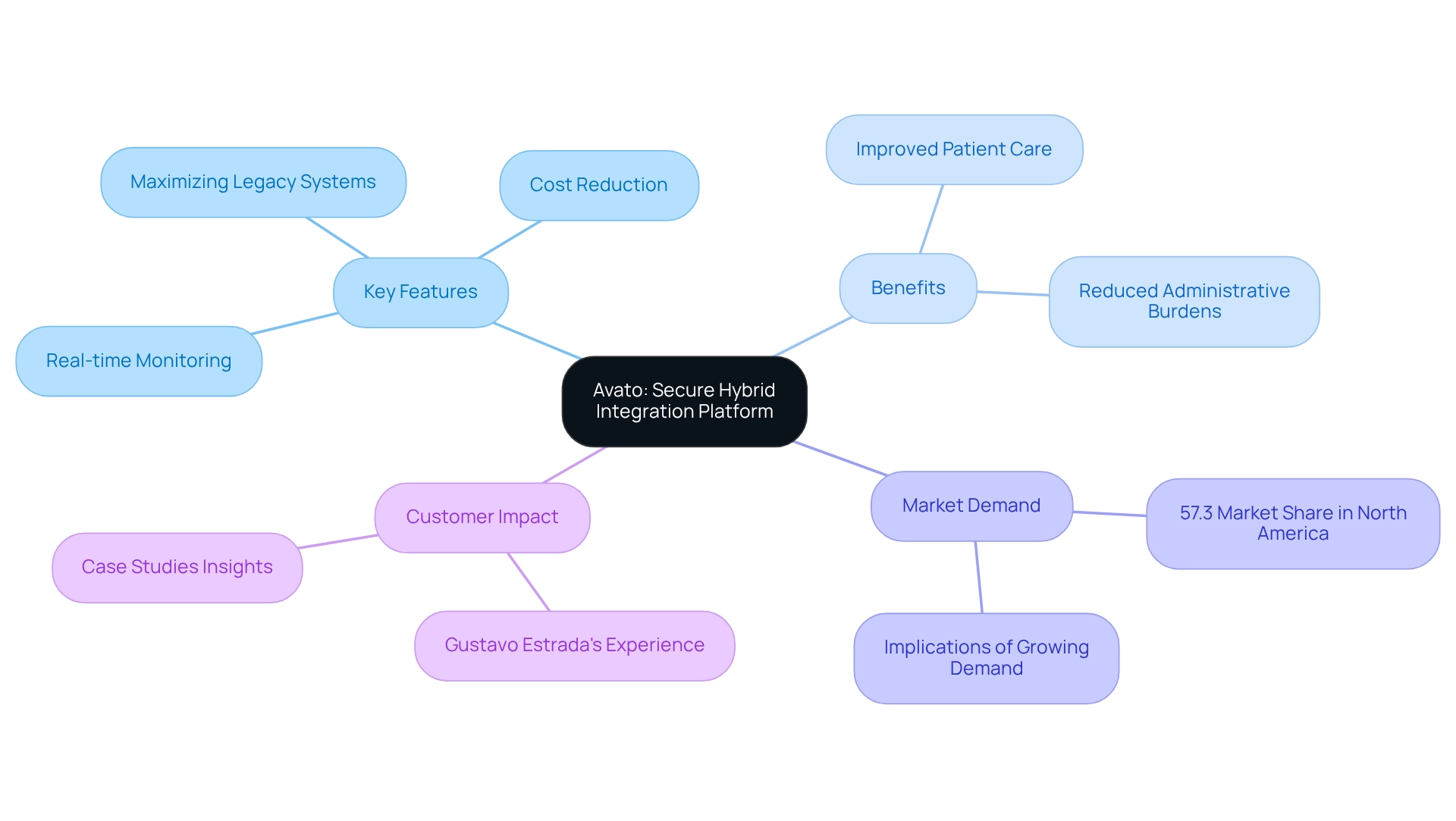
UiPath: Streamlining Administrative Tasks with Robotic Process Automation
We harness the power of robotic process automation (RPA) as examples of automation in healthcare to revolutionize administrative tasks within the medical field, such as scheduling, claims processing, and data entry. By automating these repetitive functions, we enable medical organizations to significantly reduce errors and allow staff to concentrate more on client care.
For instance, our solutions serve as examples of automation in healthcare by streamlining insurance verification and appointment reminders, resulting in enhanced operational efficiency and improved patient satisfaction. The medical RPA market is projected to reach $3.97 billion by 2029, with a compound annual growth rate (CAGR) of 14.8%. This underscores the increasing reliance on examples of automation in healthcare to drive efficiency.
Furthermore, the examples of automation in healthcare, particularly RPA adoption, could potentially save the medical sector $17.6 billion annually, especially in processes like insurance verification and pre-authorization, which can see time reductions of up to 90%. This transition not only alleviates administrative burdens but also includes examples of automation in healthcare to foster a more patient-centered approach to care.
Notably, only 17% of organizations encountered employee resistance during RPA pilot programs, indicating a generally positive reception to automation initiatives. As Prashant Nimkar observes, ‘The future offers significant potential for AI and RPA, with progress in predictive analytics, precision medicine, and user engagement, ultimately resulting in a more efficient, effective, individual-focused system of care, as seen in examples of automation in healthcare.’
Additionally, our hybrid integration platform, featuring seamless data connectivity and real-time analytics, plays a crucial role in overcoming integration challenges. This was exemplified by our success at the BC Provincial Health Services Authority, which provided examples of automation in healthcare that showcase the tangible benefits of RPA in enhancing medical efficiency and facilitating a seamless digital transformation.
Teladoc Health: Transforming Patient Care through Telehealth Solutions
At Teladoc Health, we are at the forefront of telehealth innovation, offering extensive virtual support solutions that seamlessly connect individuals with medical professionals. This transformation facilitates prompt consultations, significantly reducing the need for in-person visits and enhancing access to care, particularly for those in remote areas.
By harnessing advanced technologies such as artificial intelligence (AI) and virtual reality (VR), we can create examples of automation in healthcare that not only foster engagement but also elevate satisfaction levels, making healthcare more accessible and efficient. For instance, examples of automation in healthcare include:
- AI serving as a reliable advisor by providing individuals with comprehensive insights into their treatment options
- VR has proven effective in alleviating pain perception during medical procedures, similar to the applications seen in the Centre for Digital Business’s SimCoach program
Recent statistics reveal that 84 percent of physicians were conducting virtual visits as of April 2021, with 57 percent expressing a preference for continuing these services. As telehealth increasingly becomes the new standard in medical care, its potential to enhance access and satisfaction is being widely recognized.
Furthermore, the ongoing evolution of telehealth solutions, including those from Teladoc, underscores the importance of adapting to changing medical needs while prioritizing treatment. However, the future of remote prescribing for controlled substances will hinge on upcoming decisions by the Drug Enforcement Administration, which could influence telehealth practices.
Additionally, the surge in telehealth adoption during the pandemic was propelled by new Medicare reimbursement flexibilities, yet these policies are set to expire at the end of 2024, highlighting the regulatory challenges that lie ahead. As indicated in the McKinsey Physician Insights Survey, the shift towards virtual care is significant, and understanding these dynamics is crucial for stakeholders in the medical financing sector.
Moreover, the importance of data ownership and accessibility for individuals cannot be overlooked, as empowering individuals with control over their medical information is essential for exploring new treatment options and enhancing the overall effectiveness of digital health services.
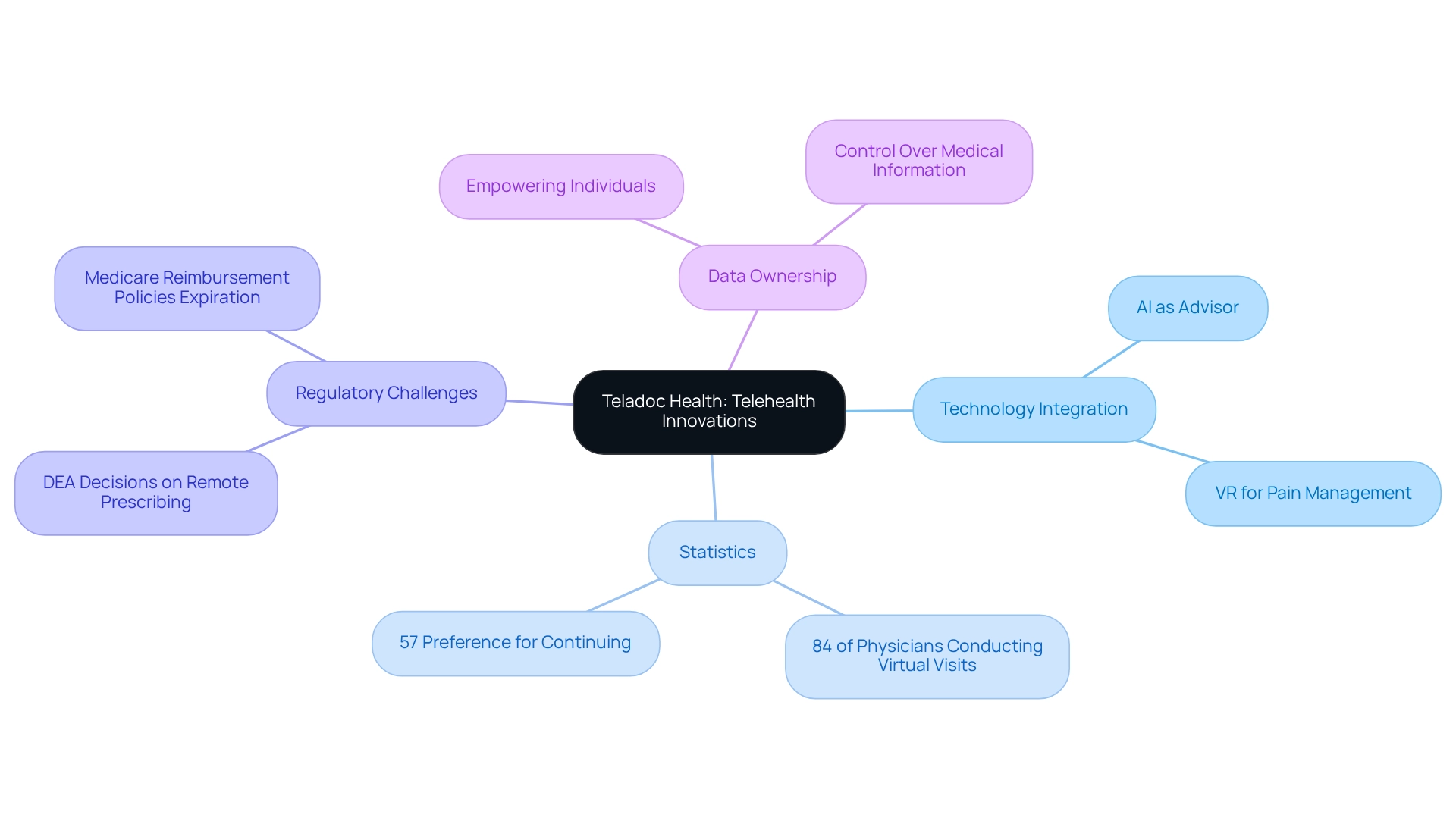
IBM Watson Health: Enhancing Diagnostic Accuracy with AI Technology
At IBM Watson Health, we leverage artificial intelligence to significantly enhance diagnostic accuracy and bolster clinical decision-making. By meticulously analyzing extensive medical datasets, we identify critical patterns and recommend tailored treatment options, effectively minimizing the risk of misdiagnosis. This AI-driven approach not only enhances outcomes for individuals but also streamlines processes for medical professionals, allowing them to make quick, informed decisions.
Remarkably, 50% of medical professionals strongly believe that AI will improve the quality of treatment, underscoring its potential to transform patient care. Furthermore, a recent survey revealed that 91% of respondents emphasized the importance of ensuring that AI-generated materials are developed by qualified medical experts before being utilized in clinical settings. This highlights the necessity of trust in AI products, which can be cultivated through transparent problem reporting and resolution channels, ensuring that medical providers feel confident in the technologies they utilize.
As shown through various examples of automation in healthcare, such as the use of AI in skin cancer detection, where 52% of respondents see AI as a major breakthrough, the integration of AI technologies is transforming the landscape of medical diagnostics and decision-making. The positive outcomes from these applications illustrate the growing acceptance of AI in enhancing early detection and treatment, showcasing examples of automation in healthcare that further solidify its role in modern practices.
Moreover, entities such as Kugler Vision are incorporating AI technology as a component of their digital transformation process, which features examples of automation in healthcare, focusing on health information technology and technology for individuals. This reflects the broader trend of integrating advanced technologies, such as virtual reality and AI, to enhance clinical efficiency, humanize interactions, and improve data accessibility, ultimately resulting in better care.
For instance, the application of virtual reality in pain management has yielded encouraging outcomes, enabling individuals to experience diminished pain perception during procedures. Additionally, AI avatars are being utilized to offer customized interactions with individuals, ensuring they receive comprehensive information about their treatment options. These advancements not only highlight the benefits of digital medicine over traditional pharmaceuticals, such as fewer side effects and reduced risk of addiction, but also emphasize the importance of humanizing healthcare through technology.
Omnicell: Improving Patient Safety with Automated Medication Management
At Omnicell, we recognize that examples of automation in healthcare, specifically advanced automated medication management systems, are pivotal in enhancing safety by significantly reducing medication errors. Our innovative solutions, such as automated dispensing cabinets (ADCs) and comprehensive medication tracking systems, guarantee that the correct medication is delivered to the appropriate individual at the right time. A recent study demonstrated that integrating ADCs with Barcode Medication Administration (BCMA) led to a decrease in overall medication errors from 19.5% to 15.8%, with dose omissions dropping from 4.6% to 2.0%. This underscores the effectiveness of examples of automation in healthcare for bolstering medication safety.
By streamlining these essential processes, we empower medical facilities to mitigate the risks associated with manual medication administration, ultimately enhancing care for individuals. The implementation of our systems not only improves accuracy but also fosters a safer clinical environment, allowing medical professionals to focus more on patient interactions rather than administrative tasks. As Gustavo Estrada from BC Provincial Health Services Authority noted, “Avato has streamlined intricate projects and produced outcomes within expected timelines and financial limits,” highlighting the importance of reliable systems in healthcare, particularly those supported by Avato’s collaboration with Red Hat, which enhances hybrid integration through enterprise open-source approaches.
Moreover, a systematic review reveals variability in reporting outcomes across studies on medication management systems, emphasizing the necessity for consistent data to validate the effectiveness of these technologies. Our commitment to providing 24/7 uptime for essential integrations further reinforces the reliability of automated systems in medical environments. However, it is crucial to acknowledge the potential risks and challenges associated with implementing these automated systems, as understanding these complexities is vital for successful integration. As the medical field continues to evolve, the importance of examples of automation in healthcare, particularly automated medication management systems, in ensuring safety for individuals cannot be overstated.
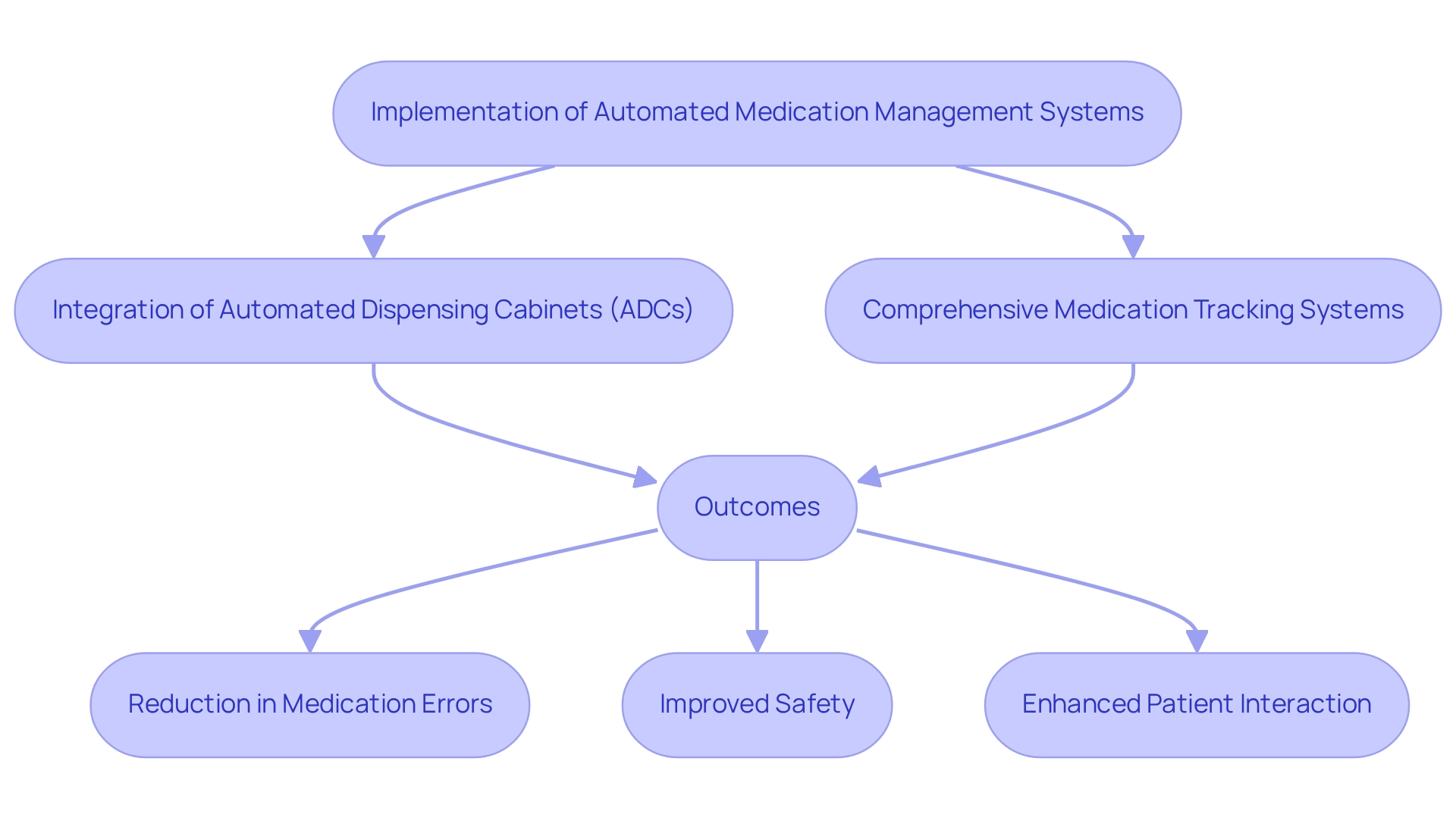
Philips: Advancing Patient Care with Remote Monitoring Solutions
At Avato, we recognize the critical importance of real-time remote monitoring solutions as examples of automation in healthcare that empower medical professionals to oversee individual well-being effectively. Our advanced technologies are prime examples of automation in healthcare, enabling continuous tracking of vital signs and health metrics, facilitating timely interventions and the formulation of personalized care plans. Integrating remote monitoring serves as one of the key examples of automation in healthcare, allowing us to significantly enhance individual engagement and improve health outcomes, particularly in managing chronic illnesses.
The rising prevalence of chronic illnesses in the U.S., which includes over 500,000 cancer-related deaths and 1.9 million new cancer cases in 2022, underscores the urgent need for efficient remote monitoring strategies. Remarkably, examples of automation in healthcare like remote patient monitoring (RPM) have been shown to reduce annual medical costs for diabetic patients by an impressive $5,000 each. With the RPM market projected to grow from USD 1.45 billion in 2021 to USD 4.07 billion by 2030, reflecting a compound annual growth rate (CAGR) of 8.74%, the adoption of examples of automation in healthcare technologies is becoming increasingly vital.
Moreover, the integration of digital medicine, particularly through AI and VR, is transforming healthcare by offering innovative examples of automation in healthcare that enhance the human experience. For instance, AI-driven avatars are examples of automation in healthcare that can provide personalized guidance and information to patients, thereby improving their understanding of treatment options and fostering a more compassionate support environment. Case studies illustrate examples of automation in healthcare by showing the effectiveness of our remote monitoring methods in enhancing health outcomes. Continuous support and adjustments in telemedicine are important examples of automation in healthcare that ensure minimal service disruptions, facilitating ongoing improvements in healthcare delivery. This adaptability is essential for maintaining the relevance and efficacy of our services over time. Our RPM solutions align with these insights, demonstrating their positive impact on healthcare.
Healthcare providers are increasingly acknowledging the transformative potential of our monitoring tools, which serve as examples of automation in healthcare, recognizing their role in enhancing care and optimizing clinical workflows. As Gustavo Estrada from BC Provincial Health Services Authority stated, “Avato has streamlined intricate projects and provided outcomes within preferred timelines and financial limitations,” which underscores the importance of efficient solutions in the medical landscape. By adopting these technologies, which are examples of automation in healthcare, medical organizations can not only improve patient outcomes but also optimize their operational capabilities, ultimately contributing to a more efficient healthcare system.
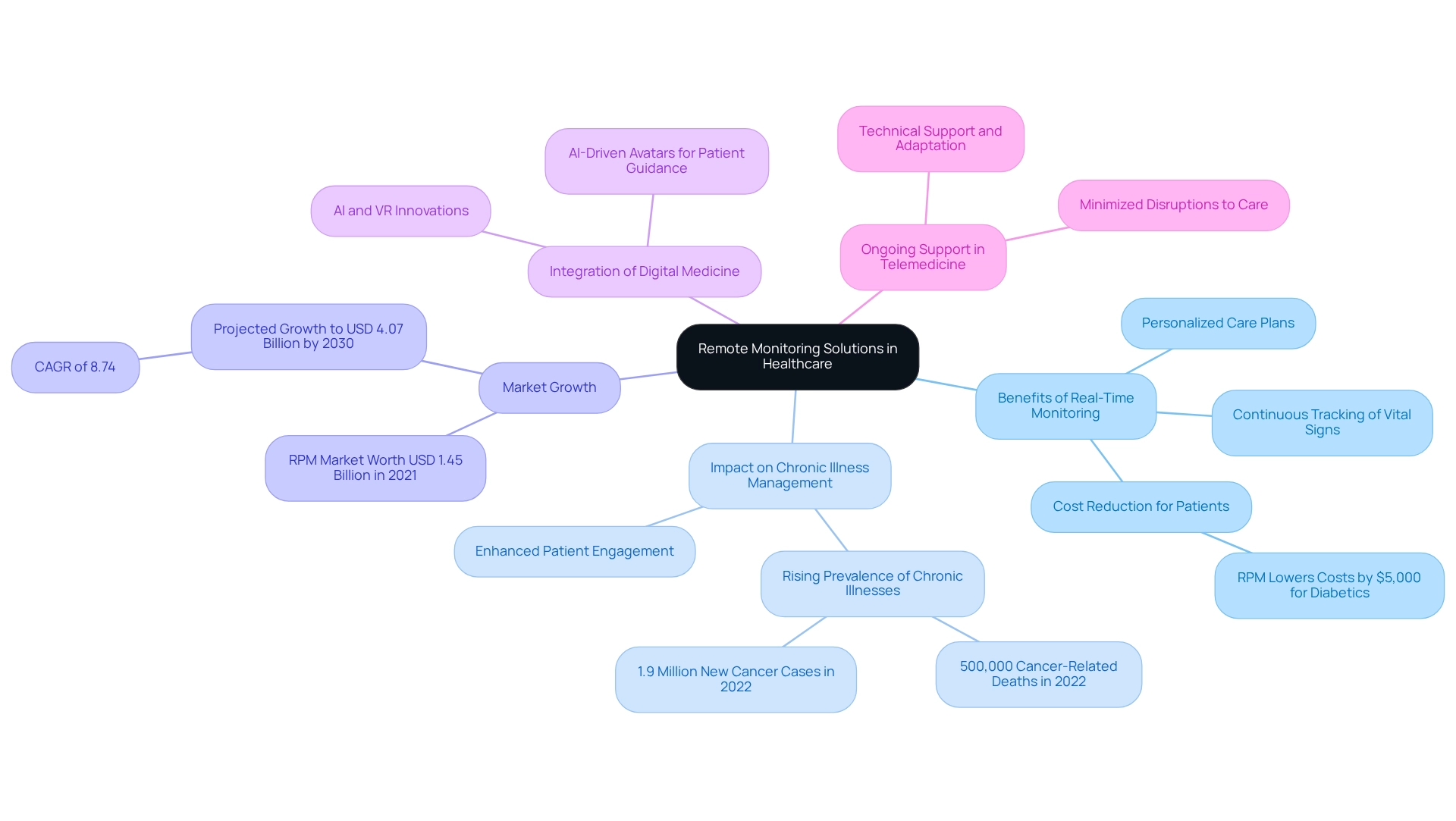
Epic Systems: Revolutionizing Patient Data Management with EHR Automation
We at Epic Systems are revolutionizing data management related to individuals through our advanced EHR automation. By simplifying data entry, retrieval, and sharing, our platform ensures healthcare providers have immediate access to precise and current information about individuals. There are several examples of automation in healthcare that significantly reduce administrative burdens, allowing clinicians to devote more time to healthcare rather than paperwork. Recent advancements in EHR automation have demonstrated a remarkable impact on clinical workflows. For instance, examples of automation in healthcare, including the implementation of our EHR systems, have been shown to decrease the time needed to access individual information by up to 80%, thereby improving the efficiency of care delivery. Furthermore, our EHR solutions promote interoperability, enabling seamless sharing of patient data among various providers, which is essential for coordinated care.
Case studies underline the effectiveness of Epic Systems in enhancing patient data management. Medical organizations can minimize errors and ensure that essential information is readily accessible when needed by implementing examples of automation in healthcare for routine tasks. This not only enhances the quality of service but also supports better decision-making processes for medical professionals. The integration of AI and VR technologies into healthcare, such as the application of virtual avatars for interactions with individuals, further humanizes the healthcare experience, facilitating more personalized and effective treatment options.
As the healthcare landscape continues to evolve, the importance of streamlined data processes becomes increasingly clear, highlighting the necessity for robust EHR automation solutions. For banking IT managers, considering the integration of EHR automation can lead to enhanced operational efficiency and improved care outcomes.
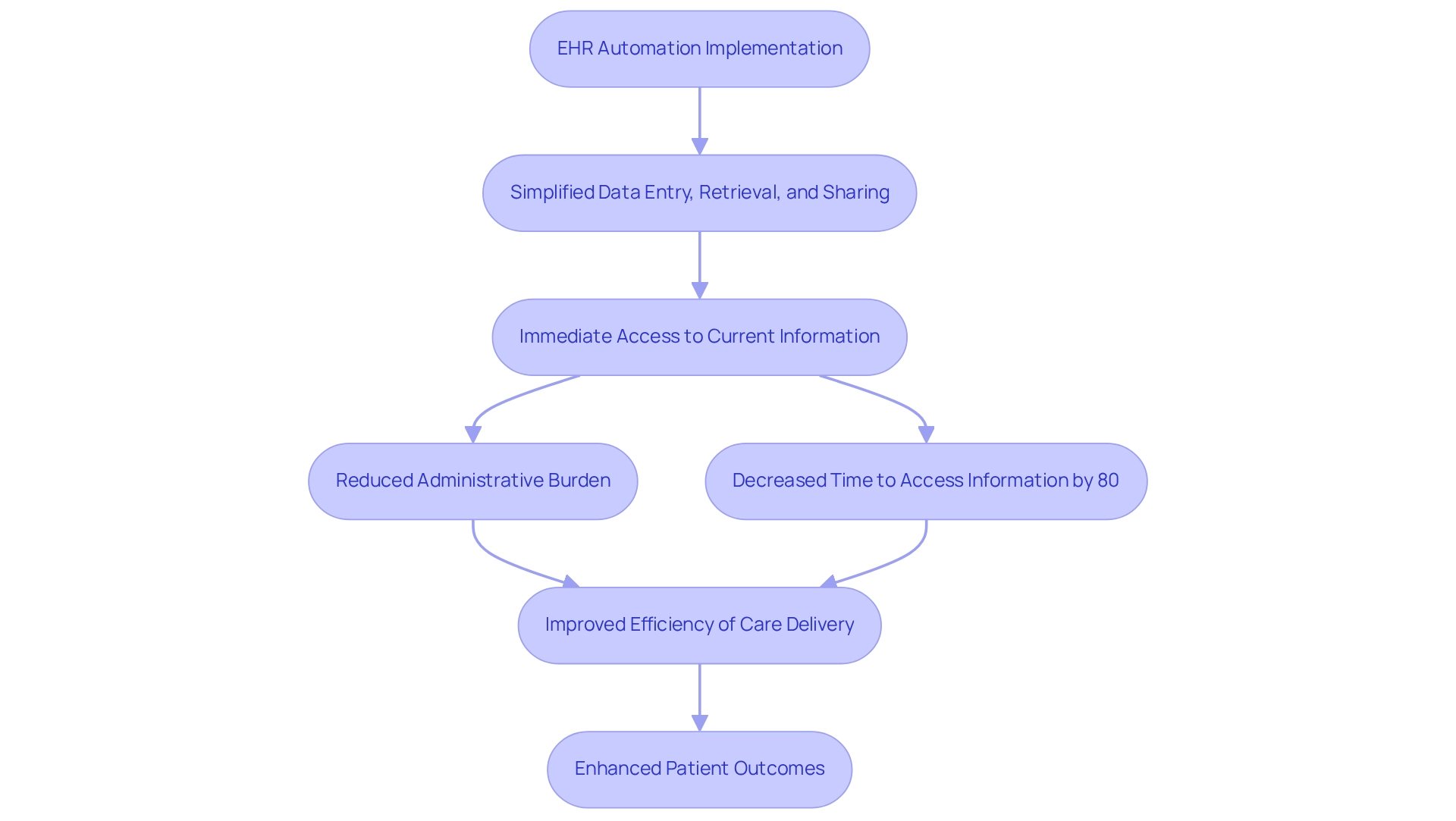
HealthTap: Enhancing Patient Engagement with AI-Powered Chatbots
At HealthTap, we harness the power of AI-driven chatbots to transform user engagement, offering instant access to essential health information and assistance. These chatbots facilitate a range of functions, from symptom assessments to appointment scheduling and addressing common health inquiries. By streamlining communication and enhancing accessibility, our solutions empower individuals to take an active role in their wellness journeys, reflecting the broader trend of digital medicine that prioritizes humanizing care through technology.
Research indicates that examples of automation in healthcare, such as integrating chatbots, can significantly improve the management of chronic conditions, showcasing their potential to revolutionize interactions with patients. The convenience of 24/7 access to health information, coupled with the perceived confidentiality of engaging with a chatbot rather than a human, makes these tools particularly appealing. As Michelle Clark aptly states, “The convenience of 24/7 access to health information and the perceived confidentiality of communicating with a computer rather than a person are attributes that make AI chatbots attractive for individuals to utilize.”
Moreover, the expansion of the Virtual Assistants market within the medical sector underscores a growing reliance on digital health solutions, reflecting our increasing dependence on technology for medical delivery. This trend is corroborated by research published in the American Journal of Managed Care, which highlights the advantages of chatbots in managing chronic conditions. However, it is crucial to acknowledge that this reliance may disproportionately impact vulnerable populations with limited access to digital resources, emphasizing the necessity for equitable technology integration.
Case studies provide examples of automation in healthcare, showcasing the effectiveness of our AI-powered chatbots in enhancing communication with individuals, with healthcare professionals noting their positive impact on satisfaction and engagement. The advancements in AI and VR technologies, as discussed at the Interface Summit, further illustrate how these tools can humanize care by offering personalized support and information. For example, the application of VR in pain management has yielded promising results, allowing individuals to engage in immersive experiences that divert attention from discomfort. Despite the potential benefits, challenges in evaluating chatbot effectiveness remain, highlighting the need for standardized evaluation tools and ongoing research to ensure the effective integration of chatbots into standard healthcare practices. Additionally, we must consider the possible side effects and limitations of relying solely on digital solutions, along with the importance of data ownership and accessibility in realizing the full potential of these technologies. As natural language processing (NLP) technology evolves, our chatbots are becoming increasingly adept at understanding and addressing inquiries, further elevating the quality of service we provide.
In summary, our innovative application of AI chatbots not only enhances user interaction but also represents a significant advancement in medical communication, paving the way for more efficient and accessible healthcare services.
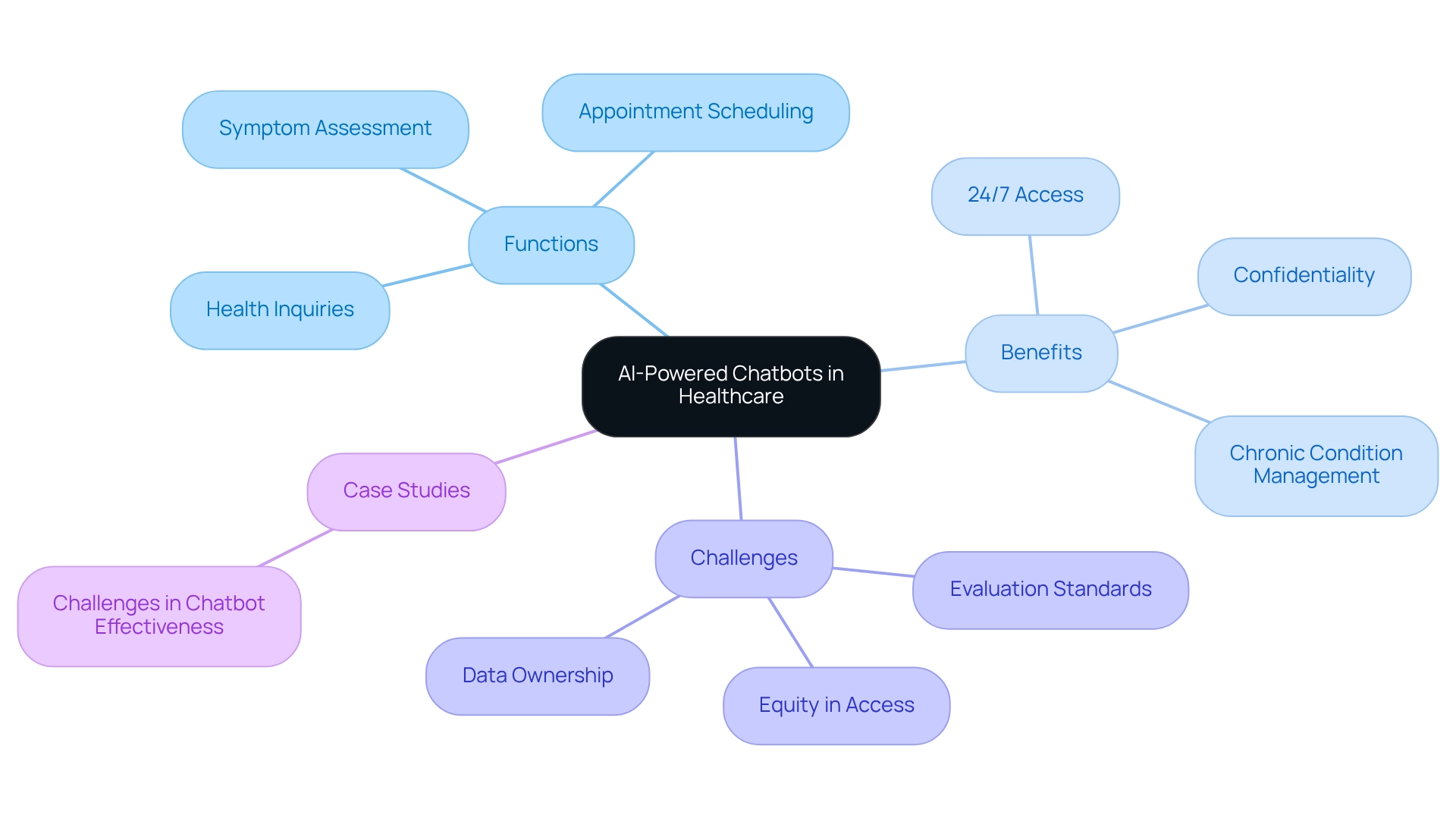
Cerner: Utilizing Predictive Analytics for Proactive Patient Care
We harness predictive analytics to significantly enhance proactive healthcare by identifying at-risk individuals and optimizing resource allocation. By meticulously analyzing historical data and emerging trends, our solutions empower medical providers to anticipate individuals’ needs and intervene before complications arise. This proactive approach not only leads to improved outcomes for individuals but also boosts operational efficiency across medical systems.
For example, our enhanced Framingham Risk Score for cardiovascular disease demonstrates an impressive 22% improvement in predictive accuracy compared to traditional methods, highlighting the effectiveness of data-driven approaches in clinical settings. As analysts emphasize, the ability to leverage data effectively is crucial; organizations that neglect this risk falling behind in an increasingly competitive environment.
Our commitment to employing predictive analytics illustrates how data can transform patient care, ensuring that medical providers are equipped to deliver timely and effective interventions. Furthermore, as Gustavo Estrada from BC Provincial Health Services Authority points out, effective integration solutions like those offered by Avato can enhance operational efficiency in medical environments, underscoring the importance of timely delivery and adherence to budget constraints.
Avato’s Hybrid Integration Platform maximizes the value of legacy systems, simplifies complex integrations, and provides real-time monitoring and alerts on system performance, resulting in significant cost reductions while ensuring 24/7 uptime and reliability. Additionally, Ernest Dimnet’s insight into the necessity of data-driven decision-making reinforces the argument for predictive analytics, emphasizing that our potential for innovation and growth is directly linked to the data we collect and utilize.
Hilary Mason also notes that while predictive analytics is powerful, the human element remains essential in interpreting and acting on data insights. This comprehensive perspective is vital as investments in digital wellness continue to grow, particularly beyond the U.S., highlighting the increasing importance of examples of automation in healthcare.
Kareo: Streamlining Billing and Claims Processing with Automation
In today’s rapidly evolving medical landscape, we recognize that examples of automation in healthcare, particularly in billing and claims processing, are not just beneficial; they are essential. We provide innovative automation solutions that significantly simplify these processes for medical providers. By automating essential tasks such as claim submissions, payment tracking, and invoicing for clients, we alleviate administrative burdens, leading to improved cash flow for medical practices. This improved efficiency not only strengthens the financial well-being of medical organizations but also allows providers to allocate more time to delivering quality service.
The incorporation of digital medicine, especially via AI and VR, is transforming how healthcare is managed. For instance, AI-driven solutions can offer personalized insights and support, enhancing the patient experience and enabling providers to concentrate on delivering compassionate care. Notably, advancements in VR technology have shown remarkable results in pain management, such as reducing a child’s perception of pain during needle procedures or easing the discomfort of burn victims during bandage changes. Statistics reveal that a substantial portion of medical billers and coders, approximately 66%, are aged 40 and older, with 65.7% identifying as White. This demographic shift emphasizes the urgency for examples of automation in healthcare, especially as we confront a rising demand for efficiency amid an aging workforce. For banking IT managers, comprehending these trends is essential, as they highlight potential effects on financial operations within the medical sector.
Furthermore, expert opinions underscore the transformative potential of examples of automation in healthcare within claims processing. Leaders in medical finance assert that offerings such as ours can greatly improve operational efficiency, enabling practices to optimize their revenue cycle management. For instance, the case study titled “The Importance of Process Optimization” illustrates that organizations prioritizing process optimization before automation often see better outcomes. Unoptimized processes can hinder success, making it imperative to address these issues before implementing automation.
Our automation capabilities serve as examples of automation in healthcare, improving claims processing efficiency and contributing to the overall financial stability of medical practices. By decreasing the time allocated to administrative duties, medical providers can concentrate on what genuinely matters: improving patient care and outcomes. As Varun Ganapathi, Chief Technology Officer and Co-Founder, states, “Solutions that employ cutting-edge GenAI, coupled with guiding expertise from industry veterans, are the best answer to help us create the premier revenue cycle management department of the future.” This perspective reinforces the importance of integrating advanced solutions in both healthcare and banking sectors to drive efficiency and effectiveness.
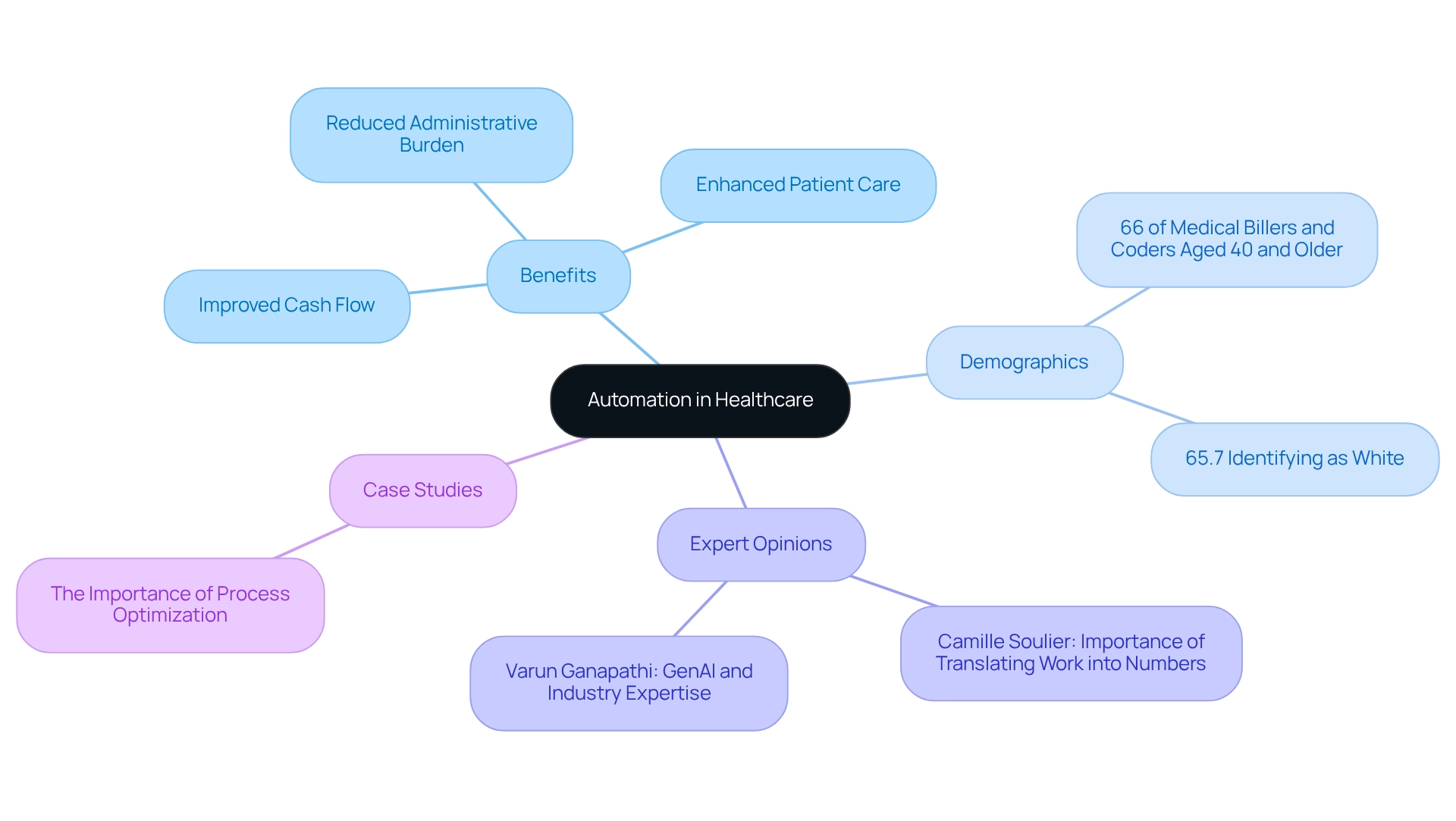
Conclusion
The integration of advanced technologies in healthcare is not just a trend; it is revolutionizing patient care and operational efficiency across the sector. We see this through Avato’s hybrid integration platform, which enhances data connectivity and automates critical processes, and UiPath’s robotic process automation that streamlines administrative tasks. By reducing burdens, we enable healthcare professionals to focus on what truly matters—patient outcomes.
Telehealth solutions from Teladoc Health are redefining access to care, particularly for those in remote areas. Meanwhile, IBM Watson Health is elevating diagnostic accuracy through AI, effectively minimizing the risks of misdiagnosis. Our automated medication management systems from Omnicell improve patient safety by significantly reducing medication errors, while Philips’ remote monitoring solutions facilitate real-time health tracking, which is crucial for managing chronic diseases effectively.
As the healthcare landscape continues to evolve, the role of predictive analytics and automation—demonstrated by Cerner and Kareo—becomes increasingly vital. These advancements not only enhance operational efficiencies but also empower us as healthcare providers to deliver more personalized, effective care.
Ultimately, embracing these technological innovations is essential for all stakeholders in the healthcare industry. By understanding and leveraging the potential of these solutions, we can navigate the complexities of modern healthcare delivery, ensuring improved patient outcomes and streamlined operations. The future of healthcare lies in the integration of technology, promising a more efficient, patient-centered approach to care.

